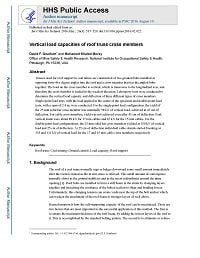Mining Publication: Vertical Load Capacities of Roof Truss Cross Members
Original creation date: May 2016
Authors: DF Gearhart, KM Mohamed
Trusses used for roof support in coal mines are constructed of two grouted bolts installed at opposing forty-five degree angles into the roof and a cross member that ties the angled bolts together. The load on the cross member is vertical, which is transverse to the longitudinal axis, and therefore the cross member is loaded in the weakest direction. Laboratory tests were conducted to determine the vertical load capacity and deflection of three different types of cross members. Single-point load tests, with the load applied in the center of the specimen and double-point load tests, with a span of 2.4 m, were conducted. For the single-point load configuration, the yield of the 25 mm solid bar cross member was nominally 98 kN of vertical load, achieved at 42 cm of deflection. For cable cross members, yield was not achieved even after 45 cm of deflection. Peak vertical loads were about 89 kN for 17 mm cables and 67 kN for the 15 mm cables. For the double-point load configurations, the 25 mm solid bar cross members yielded at 150 kN of vertical load and 25 cm of deflection. At 25 cm of deflection individual cable strands started breaking at 133 and 111 kN of vertical load for the 17 and 15 mm cable cross members respectively.

- Diagnosing and Controlling Moisture-Sensitive Roof in Coal Mines
- Optimizing Secondary Roof Support with the NIOSH Support Technology Optimization Program (STOP)
- Overview of Coal Mine Ground Control Issues in the Illinois Basin
- Pillar and Roof Span Design Guidelines for Underground Stone Mines
- Preventing Falls of Ground in Coal Mines With Exceptionally Low-Strength Roof: Two Case Studies
- Pumpable Roof Supports: Developing Design Criteria by Measurement of the Ground Reaction Curve
- Technology News 482 - Ground Support Safety Training Video
- Technology News 493 - Proceedings: New Technology for Coal Mine Roof Support
- Tests of Fibre-Reinforced Shotcrete at the Chief Joseph Mine, Butte, Montana
- Updating the NIOSH Support Technology Optimization Program (STOP) With New Support Technologies and Additional Design Features